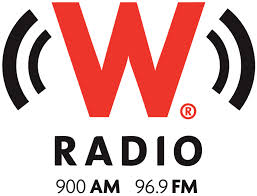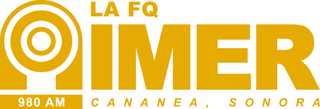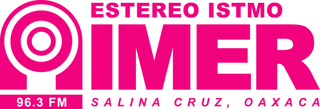
XEW-AM is a radio station in Mexico City, Mexico, broadcasting on the AM frequency of 900 kHz; it is branded as W Radio. XEW-AM serves as the originating station for other "W Radio" stations around Mexico that carry some of its programs. The programming on XEW-AM is also simulcast on Mexico City FM radio station 96.9 XEW-FM.

XERA is a radio station in Mexico, broadcasting on 760 AM in San Cristóbal de las Casas, Chiapas, Mexico. The station's callsign was most famous for its use on a border blaster at Villa Acuña, Coahuila.

Radiópolis is a Mexican radio broadcast company that owns AM and FM radio stations in Mexico and syndicates music and talk formats. It is the former radio division of Televisa, which spun its stake off to Corporativo Coral, S.A. de C.V., in 2020 to focus on its core television and telecommunications businesses. Since 2001, Radiópolis has been a joint venture with Spanish media conglomerate Grupo PRISA.
XEQ-AM is a commercial class A clear channel AM radio station in Mexico City. The concession is held by Cadena Radiodifusora Mexicana, S.A. de C.V. and is operated by Radiópolis. XEQ-AM broadcasts from a transmitter located at Los Reyes Acaquilpan, on Boulevard Generalísimo Morelos, east of Mexico City.

XEK-AM/XHK-FM, known as La Grande, is a radio station on 960 kHz and 90.9 MHz serving the Laredo, Texas, United States and Nuevo Laredo, Tamaulipas, Mexico border area.
XHIMER-FM is a radio station in the Mexican capital Mexico City. The station is owned by the Instituto Mexicano de la Radio (IMER) and broadcasts a classical music format under the brand name Opus 94 from a tower on Cerro del Chiquihuite.
XEQK-AM is a radio station in Mexico City, Mexico. Broadcasting on 1350 AM, XEQK-AM is owned by the Instituto Mexicano de la Radio and broadcasts a citizen-sourced talk and music format under the brand name Radio Ciudadana.
XEDTL-AM is a radio station in the Mexican capital Mexico City. Broadcasting on 660 AM, XEDTL-AM is owned by the Instituto Mexicano de la Radio and broadcasts a tropical music format under the brand name Tropicalísima.

XEMP-AM is a radio station in the Mexican capital Mexico City. Broadcasting on 710 AM, XEMP-AM is owned by the Instituto Mexicano de la Radio and broadcasts a regional Mexican format under the name Radio 710.

XHFQ-FM is a Mexican radio station in Cananea, Sonora. Broadcasting on 103.1 FM, XHFQ is owned by the Instituto Mexicano de la Radio and broadcasts a varied music format under the name "La FQ".

XHCHZ-FM is a radio station in Chiapa de Corzo, Chiapas, Mexico. Broadcasting on 107.9 FM, XHCHZ-FM is owned by the Instituto Mexicano de la Radio and broadcasts a music and information format under the name "Radio Lagarto".

XHSCO-FM is a radio station in Salina Cruz, Oaxaca, Mexico. Broadcasting on 96.3 FM, XHSCO-FM is owned by the Instituto Mexicano de la Radio and broadcasts a news and music format under the name "Estéreo Istmo".
XEQ-FM is a radio station in Mexico City. Broadcasting on 92.9 FM, XEQ-FM broadcasts grupera music under the name "La Ke Buena" and is the flagship of a network of stations with the same branding and format.
XERED-AM is a radio station in Mexico City. Located on 1110 kHz, XERED-AM is owned by Grupo Radio Centro broadcasting a talk format based on news and sports known as Radio Red. 1110 AM is a United States clear-channel frequency.

XECO-AM is a radio station on 1380 AM in Mexico City. XECO-AM is owned by Grupo Audiorama Comunicaciones and broadcasts a romantic music format as "Romántica".
XEBS-AM is a radio station on 1410 AM in Mexico City. XEBS-AM is owned by NRM Comunicaciones and broadcasts a tropical music format under the name Sabrosita
XERFR-AM 970/XERFR-FM 103.3 is a radio station in Mexico City. It is the flagship of Radio Fórmula's Primera Cadena.
XEDF-AM 1500/XEDF-FM 104.1 is a radio station in Mexico City. It is the flagship of Radio Fórmula's Segunda Cadena. 1500 AM is a United States clear-channel frequency.
XHIRC-FM is a radio station serving Colima, Colima, in central−western Mexico. The station is owned by the state of Colima through the Instituto Colimense de Radio y Televisión and broadcasts on 98.1 MHz.

Radio in Mexico is a mass medium with 98 percent national penetration and a wider diversity of owners and programming than on television. In a model similar to that of radio in the United States, Mexican radio in its history has been largely commercial, but with a strong state presence and a rising number of noncommercial stations in the 2000s and early 2010s. In August 2015, there were 1,999 legal radio stations, almost 75 percent of them on the FM band.










